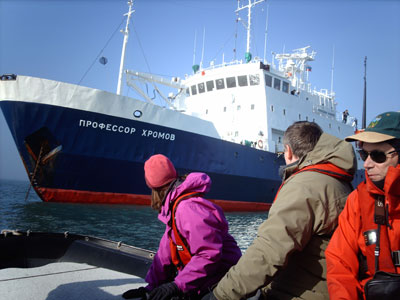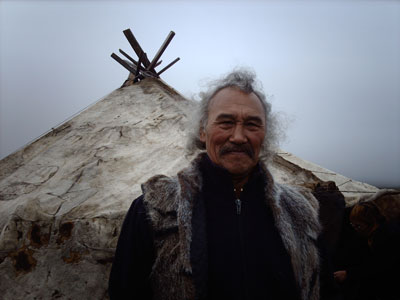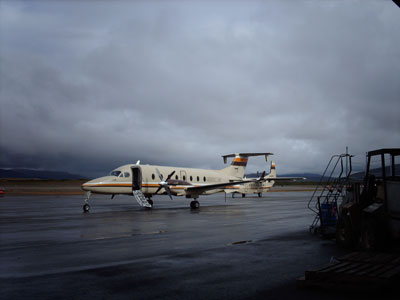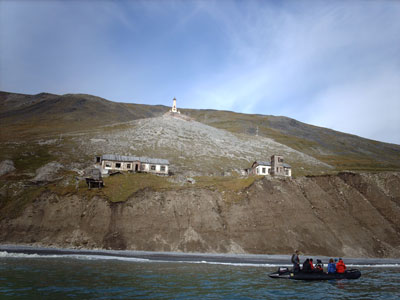Extraordinary wildlife and extreme conditions on a Russian Far East cruise
by Lynn Remly; Hudson, OH
Disembarking the Zodiac, I turned to see an enchanting phenomenon: right where you’d expect it on a misty day was a rainbow, but this one was white, not multicolored. It was the first time I’d seen an ice rainbow, one of many wonders our group encountered on an August ’11 trip to the Chukotka Peninsula and Wrangel Island in the Russian Far East.
Getting there
I booked this two-week expedition cruise through Arctic Odysseys (Seattle, WA; 800/574-3021), though the actual supplier was Heritage Expeditions (Christchurch, New Zealand; phone 64 [0] 3 365 3500).
I arrived in Nome, Alaska, a day before my scheduled charter flight to Anadyr, staying at the recommended Aurora Inn (800/354-4606) for $165 plus taxes (single), not including breakfast but offering free wireless Internet access. Tour members who overnighted at the Aurora gathered the next morning to share a cab to the airport.
While waiting for our luggage to be sorted and weighed in order to properly balance the small aircraft, a Heritage naturalist led us on an optional walk to see a herd of musk oxen that had wandered onto the airport grounds. These huge animals, leftovers of the last ice age, did not perform their circle-the-wagons maneuver, which they use as protection against predators, so we concluded that they were accustomed to humans, to a certain extent.
A relatively short Customs procedure (for Russia, that is) followed the 2-hour flight to Anadyr, across the Bering Strait and across the International Date Line. We then took the local ferry from the airport to the town proper, while our luggage was taken immediately to the ship.
A colorful introduction
While waiting to board our ship, the Spirit of Enderby, most of us set off for a brief walking tour of Anadyr despite the fierce, cold wind and rain — not exactly surprising for the easternmost town in Russia.
The town was unexpectedly clean and bright, thanks mainly to its billionaire ex-governor, Roman Abramovich, better known as the owner of the Chelsea Football Club. Its buildings were freshly painted pink, yellow and blue — a remarkable contrast to the brown tundra all around and the endless stretch of shabby, dying towns across Siberia and the Russian Far East.
I teamed up with two other ladies to walk up to the Cathedral of the Holy Trinity, one of the largest wooden Orthodox cathedrals in the world and still smelling of new-sawn wood. We then walked down to the monument to Saint Nicholas, patron saint of sailors and travelers, looking out over the threatening waters of Anadyr Bay. We hoped that St. Nicholas would be paying attention as we embarked later that evening.
We finally made it back to the point where the Zodiacs would pick us up, charmed by hundreds of beluga whales and largha seals sporting in the high waves. The Zodiacs (excursion boats) scooped us up for a cold, wet ride to the ship, where we were warmly welcomed by the staff and hot tea and coffee in the lounge, soon followed by dinner.
The particulars
Like so many of today’s expedition tour vessels, the Spirit of Enderby (aka “Professor Khromov”) was a Russian research vessel built for work and not luxury. The accommodations were spartan but comfortable.
I had booked a twin share, but, because there were only 40 passengers on this 50-passenger ship, I had a cabin to myself and private facilities. That’s luxury enough for me.
There were, unfortunately, no comfortable seating areas on the ship. The lounge served as the bar for the daily happy hour, recap and briefings, as an area to enjoy tea, coffee or hot soup and as a very small library, but its bench seats were not particularly comfortable. However, most passengers take this trip for the wilderness and wildlife, not for the comforts of home, so no one minded. It seemed to everyone that we were paying a reasonable price for a very unusual itinerary.
The trip, itself, cost $8,200 for a shared twin and airfare to and from Nome. The charter flight from Nome to Anadyr cost an additional $750.
Comparing notes with those passengers who either preferred to come by way of Moscow or simply booked too late to take advantage of the two Bering Air 12-passenger charter flights from Nome led me to believe that the charter was well worth the money, since we avoided any major hassle and very, very long flights.
Travel insurance is required for this trip. I paid $592 for a policy that covered the tour and flight, which I booked through AccessAmerica, now called Allianz Global Assistance (800/284-8300).
The trip also required a Russian visa ($140, normal service), which I arranged through PVS International (Arlington, VA; 800/556-9990) for a fee of $50 plus an additional $35 for FedEx handling.
Local interaction
Miserable weather accompanied us on our first shore excursion, along the coast north of Mys (Cape) Achchen. The tussocks above the beach made walking very difficult for some of us, but the others — including the guides — charged off on a long walk up the nearest hill, leaving seven of us shivering on the beach for over an hour.
In the Zodiac, we cruised past sharp basalt needles jutting up out of the cold water to follow a group of walruses until it became obvious that they were trying to avoid us, so we desisted.
The next morning, the staff approached a fishing camp set up at Gilmimyl on Arakamchechen Island, inhabited by Chukchi who live in Provideniya but spend the summers there fishing for salmon. They had brought fresh bread and fruit as an overture earlier that morning, so when the rest of us came ashore, the local group was very happy to welcome us.
Tanya seemed delighted to show us around, inviting us into the skin-covered aranda, where we sat on bear and caribou skins and were warmed by a small fire which she kept going. She and Ivan, the apparent leader of the small group, were extremely friendly and generous. They gave us dried salmon to take back to the ship and even demonstrated how they take fish off their traps.
This was, unfortunately, our only experience with the indigenous people of the region, which was a pity, since the Chukchi have a very long and interesting history.
Those who wanted to went off to bathe in hot springs on the island — a nice contrast between heat and ice.
After lunch, we landed at Whalebone Alley on Yttygran Island, an archaeological treasure dating, probably, to the 14th or 15th century. As its name suggests, the site features long rows of bowhead whale bones — almost a half mile of them — stuck into the ground like totem poles, the remains of the many whales once dragged up on the beach to be processed for meat.
Although the whales were an important food source, the careful positioning of the bones in long rows indicates that the site also had some spiritual significance far beyond its being merely an abattoir.
Sadly, as we walked along the shore, we found the headless body of a huge walrus, the first we were to find on the trip. Apparently, locals chop off the head for the tusks, which they carve into souvenirs for tourists. Even if it is legal to import, I would personally never buy anything carved of walrus ivory, having seen the cruel waste it signifies.
Life on board
The Enderby maintained an open-bridge policy, and a number of passengers could be found there at any time. We spotted both gray and humpback whales — lots of them — a number of times, and someone reported seeing orcas, though I did not see any.
Our frequent onboard lectures featured birds, mammals and plants. Our expedition leader Aaron gave a brief talk one day on the geology of Herald Island, but if I had my choice, we would have had more lectures on geology as well as talks on the ethnography and history of the region. These subjects were almost ignored.
We sailed the next day around Cape Dezhnev, which lies directly across the Bering Strait from Cape Prince of Wales, Alaska. The strait is about 53 miles wide and ranges from about 90 to 150 feet deep.
The area was part of Beringia, the gigantic swath of land that connected Russia and North America during the last ice age but is now submerged. It is generally accepted that America was settled by Easterners crossing this 1,000-mile-wide land bridge into Alaska and beyond.
Wind and water kept us from our scheduled landing at Uelen Village, the easternmost settlement (not town) in Russia. Its 775 Chukchi and Yupik inhabitants are renowned as carvers of walrus bone and eagerly sell their work to tourists, but after our experiences with the headless walruses, I had no interest in fostering their trade. Hundreds of accompanying humpback whales made up for any disappointment.
Wrangel Island
We next headed toward Wrangel Island, stopping first at Kolyuchin Island, where high waves again reminded us of how tricky the currents can be where the Pacific and Arctic (actually, the Bering and Chukchi seas) converge. Bobbing in our Zodiacs, we saw hundreds of walruses swimming, honking and doing what walruses do.
In the afternoon we heard a lecture from Alexander Gruzdev, the Director of the Wrangel Island Nature Reserve. Through a translator, he explained that the island, made a reserve in 1976, was named a UNESCO Natural World Heritage Site in 2004. This means that money will be flowing into the area to create conditions that will permit study and preservation of the area’s flora and fauna.
Russia’s strictly protected lands are called zapovedniks. Somewhat surprisingly, the first, Barguzinsky, was created in 1916 on the eastern shore of Lake Baikal. Today, over 100 zapovedniks, comprising some 80 million acres and ranging from tundra to steppe, can be found from the Black Sea in the west to the Bering Sea in the far east.
For our visit to Wrangel, we all disembarked the ship at Rogers Inlet, where we joined two rangers to look at their site at Ushakovskaya, once a meteorological station supported by a functioning community of 200, including a store and school. Now the only inhabitants are rangers and scientists studying the wildlife.
Hundreds of rusted oil drums littered the beach and site, but attention resulting from the UNESCO designation and the money that comes with it should help with their removal.
We then set off on a counterclockwise circumnavigation of Wrangel Island. Though we had heard rumors of pack ice on the northwest coast, the entire coast was ice free; indeed, the ice edge was 150 miles north, a bad sign for the polar bears. We were told that 10 years ago not even an icebreaker could get to the island.
Wrangel straddles the 180-degree longitude line, so almost exactly half lies in the Eastern Hemisphere and the other half in the Western. Above all things, it is north… of the Arctic Circle and just about everything else.
Be prepared
Anyone considering this trip should be very sure to have silk or other warm underwear, fleece pants and jacket and completely waterproof gear, including gloves, knee-high boots and GORE-TEX (or similar) pants and anorak. The secret is layers, but the outer layers being waterproof is essential. Since suitcases are limited on airlines to 50 pounds, packing can require some creativity.
Our days in the Zodiacs were cold and often wet, the air temperature was around freezing, and winds whipped up the waves so that we got splashed quite often. One of the Zodiac trips to shore was about four miles, which almost guaranteed a few inundations.
I have been on many Arctic/Antarctic trips, and I have never been as cold as I was on this one. One problem, from my point of view, was that the guides didn’t stick to the posted schedule. That is, a planned 2-hour excursion could extend to 3 or 3½ hours on whim. This doesn’t sound like much, but when you’re sitting in a Zodiac whipped by winds, an hour makes a big difference.
Granted, if you’re watching polar bears frolicking 100 feet away, you don’t head back to the ship, but, failing such excitement, the comfort of the passengers has to be considered.
A harsh climate
There was little comfort to be found on forbidding Herald Island, Wrangel’s tiny neighbor and our next destination, which is charged with history.
Violently upturned layers of schist and shale, edged with granite, bespeak the island’s volcanic past. Tors, rock formations shaped like chess pieces atop the steep cliffs, loom over the narrow and scattered beaches.
The message would be clear: anyone landing there has no hope of survival. Indeed, four of the survivors of the disastrous 1914 Karluk shipwreck made it to shore there and died a lonely, cold death. Their bones were found years later.
As we cruised in our Zodiacs, several polar bears wandered the shore, and one slipped into the water. The bears were quite close, about 100 feet away.
Sailing around the ice-free northwest edge of Wrangel, we landed the next day at Florence Bay, where one group set out for a long walk and the rest of us again admired the tundra, a phenomenon well worth attention.
Tundra is an area where the tree growth is limited by low temperatures and short growing seasons and the subsoil is permafrost. Vegetation comprises only dwarf shrubs, sedges, grasses, mosses and lichens. We saw very old willow “trees” with thick trunks hugging the ground, well out of the wind.
Carpets of flowers, especially daisies and Arctic cotton, belied the harsh climate. We saw scurvy grass near the shore, a plant whose antiscorbutic properties could (and sometimes did) save the lives of sailors living on salt beef and biscuits. It always amazes me that anything can survive that far north, but this entire system does.
We walked to a hut that had been occupied by a Chukchi family until about 1981, when they were relocated as part of the island’s transformation into a wildlife reserve. The hut was solid and comfortable looking; it even had wallpaper.
Unusual encounters
The afternoon Zodiac landing involved a close encounter with a polar bear, so close that the rangers (who are the only ones armed) had to fend it off with their sticks (and not, thankfully, with their pistols).
Bears are both curious and potentially aggressive, especially the young ones. Our guide told us about a bear that actually swam out to the ship and started to climb the gangway as the crew hastily raised the steps out of the water.
The next day’s cruise to the west side of Wrangel brought bird sightings, but the highlight of the day was the “Arctic plunge,” in which some of the staff (and even one intrepid passenger) jumped into the frigid water. Extra points were given for costumes, and Batman, a hula dancer and a silver mermaid joined rangers Anatoly and Sergei and passenger Julie for the experience.
Our Arctic Circle landing at Chitigun River had to be canceled because of high winds and surf, so we continued southward, retracing our wake to Cape Dezhnev. We all noticed that we were once again experiencing darkness at night — at Wrangel, the sky faded to gray at night, then began to brighten again at 3 a.m. or so. Even with blackout curtains, it was hard not to awaken early.
Coming to an end
Our final destination was Big Diomede Island, in Russia, and Little Diomede Island, 2½ miles away in the US. They are also called Tomorrow Island and Yesterday Island, respectively, since time in the former is 20 hours ahead of the latter.
Those bobbing around in the Zodiacs had to keep within sight of the military watch station on Big Diomede, since Russia is apparently still convinced that 40 middle-aged to elderly travelers might invade the barren island 11 time zones away from Moscow.
Our final morning was a reading day for everyone, The ship stayed anchored in Kekilin Bay, as most elected to stay cozy in the library, reading and drinking tea. When the weather cleared in the afternoon, however, the Zodiacs were lowered for a final cruise to a bird cliff, but at that time of the year many migratory species were gone, according to one bird-watcher.
We then sailed back to Anadyr, where we had one last wet landing and were given a snack pack to keep us going as we waited at the airport to clear Customs and Immigration. Our Bering Air charter returned us safely to Nome.
For anyone interested in a trip to the exotic Russian Far East, particularly wildlife enthusiasts, I’d recommend a journey around Cape Dezhnyev and Wrangel Island. It’s not for the faint of heart or anyone with mobility problems, but the reward of seeing near-pristine landscapes makes the effort and expense well worth it.





